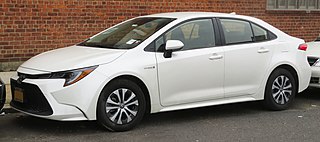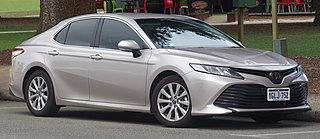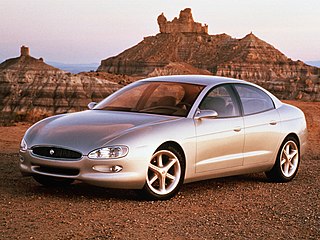
Holden, formerly known as General Motors-Holden, was an Australian automobile marque and former automobile manufacturer, which manufactured cars in Australia before switching to importing cars under the Holden brand. It was headquartered in Port Melbourne.

The Holden Commodore is a medium to large sedan sold by Holden since 1978. It was manufactured from 1978 to 2017 in Australia and from 1979 to 1990 in New Zealand, with production of the locally manufactured versions in Australia ending on 20 October 2017. Sales of the Commodore ended in 2020, coinciding with the discontinuation of the Holden brand and nameplate entirely.

The Opel Omega is an executive car engineered and manufactured by the German automaker Opel between 1986 and 2003. The first generation, the Omega A (1986–1993), superseded the Opel Rekord, was voted European Car of the Year for 1987, and was available as a saloon or estate. The second generation, the Omega B, was manufactured from 1993 to 2003.

The Holden Monaro was a rear-wheel drive coupé manufactured by General Motors Holden in Australia from 1968 to 1975 and later reintroduced from 2001 to 2005. It was also manufactured as a 4-door saloon from 1973 to 1977.

Holden Special Vehicles (HSV) is the officially designated performance vehicle division of Holden. Established in 1987 and based in Clayton, Victoria, the company modified Holden models such as the standard wheelbase Commodore, long wheelbase Caprice & Statesman and commercial Ute for domestic and export sale. HSV also modified other non-Holden cars within the General Motors portfolio in low volumes.

The Toyota Corolla is a line of subcompact and compact cars manufactured by Toyota. Introduced in 1966, the Corolla was the best-selling car worldwide by 1974 and has been one of the best-selling cars in the world since then. In 1997, the Corolla became the best selling nameplate in the world, surpassing the Volkswagen Beetle. Toyota reached the milestone of 44 million Corollas sold over twelve generations in 2016. The series has undergone several major redesigns.

The Toyota Camry is an automobile sold internationally by the Japanese manufacturer Toyota since 1982, spanning multiple generations. Originally compact in size (narrow-body), later Camry models have grown to fit the mid-size classification (wide-body)—although the two sizes co-existed in the 1990s. Since the release of the wide-bodied versions, Camry has been extolled by Toyota as the firm's second "world car" after the Corolla. In Japan, Camry was once exclusive to Toyota Corolla Store retail dealerships. Narrow-body cars also spawned a rebadged sibling in Japan, the Toyota Vista (トヨタ・ビスタ)—also introduced in 1982 and sold at Toyota Vista Store locations. Diesel fuel versions have previously retailed at Toyota Diesel Store.

The Opel Monza is an executive fastback coupe produced by the German automaker Opel from 1978 to 1986. It was marketed in the United Kingdom as the Vauxhall Royale Coupé by Vauxhall.

The Opel Antara is a compact crossover SUV which was designed and produced by the German car manufacturer Opel from 2006 to 2015. The Antara, based on the Theta platform, shared its underpinnings and powertrains with the Chevrolet Captiva. However, it only offered five seats instead of seven, and had a different exterior and interior design. Sales commenced in November 2006.

The Holden Commodore (VE) is an executive car that was produced by the Australian manufacturer Holden from 2006 to 2013. It was the first iteration of the fourth generation of this Australian-made model. Its range included the luxury variants, Holden Berlina (VE) and Holden Calais (VE); utility models were included as the Holden Ute (VE).

The Holden Commodore (VN) is a full-size car that was produced by the Australian manufacturer Holden from 1988 to 1991. It was the first iteration of the second generation of this Australian made model, which was previously a mid-size car, as well as the first Commodore available as a coupé utility. The new range included the luxury variants, Holden Berlina (VN) and Holden Calais (VN) and, from 1990, introduced the commercial Holden Utility (VG).
Holden New Zealand Limited, named until 1994 as General Motors New Zealand Limited, was a subsidiary of General Motors of Detroit and distributes General Motors' motor vehicles, engines, components and parts in New Zealand.

The Holden Commodore (VT) is an executive car that was produced by the Australian manufacturer Holden from 1997 to 2000. It was the first iteration of the third generation of this Australian made model and the last one to be powered by a locally made V8 engine (1999). Its range included the luxury variants, Holden Berlina (VT) and Holden Calais (VT) but not a new generation utility version.

The Holden Commodore (VS) is an executive car which was produced by the Australian manufacturer Holden from 1995 to 1997 and 2000 for utility versions. It was the fourth and final iteration of the second generation of this Australian made model. The range included the luxury variants, Holden Berlina (VS) and Holden Calais (VS).

The Holden Commodore (VX) is an executive car that was produced by the Australian manufacturer Holden from 2000 to 2002. It was the second iteration of the third generation of this Australian made model. Its range included the luxury variants, Holden Berlina (VX) and Holden Calais (VX), and it formed the basis for a new generation Holden Ute (VU) coupé utility and Holden Monaro (V2) coupé.

The Opel Insignia is a mid size/large family car engineered and produced by the German car manufacturer Opel. Production of the Insignia began in August 2008, as a replacement for the Vectra and Signum. The vehicle is sold under the Vauxhall marque in the United Kingdom, in Australia as the Holden Commodore, and sold in North America and China as the Buick Regal.
United Australian Automobile Industries (UAAI) was an automobile model sharing firm that operated in Australia between 1987 and 1996 as the result of an agreement between Holden and Toyota Australia. The joint venture resulted in the two companies sharing production of locally produced automobiles by selling their models under both brands.

The Holden V8 engine is an overhead valve (OHV) V8 engine that was produced by the Australian General Motors subsidiary, Holden between 1969 and 2000. The original design came from AMC in the USA, it was used in international harvesters and some AMC branded vehicles etc, however it was never considered a performance engine, nor was it popular in the USA. The AMC international harvester engine was considered by engineers as a poor design, and a poor choice for Holden to purchase the design from; so credit must be given to the Australian race engineers who managed to further develop this engine. The engine was used initially in the Holden HT series; it was later utilised in the Torana and Commodore ranges. The final iteration, the HEC 5000i, was phased out in Holden passenger vehicles upon the release of the VT II Commodore in mid 1999, which featured the Gen III V8 imported from the United States. The engine continued in the VS III Commodore utility which continued to be sold alongside the VT model until the new generation VU Ute debuted in late 2000. VS III Statesman continued with the Holden V8 engine also for a short while until the new WH Statesman was released in 1999.

XP2000 or XP-2000 was the name of a concept car produced by Buick of General Motors (GM). It was assembled in 1995 by GM's Australian division Holden, and first showcased at the North American International, Chicago, and Los Angeles auto shows that same year. Styled similarly to the then-current Commodore model, the XP2000 featured a number of new technologies that would eventually make their way into future GM vehicles. As of October 2016, the XP2000 concept is currently a part of the collection of the J.A. Cooley Museum in San Diego, California.

















